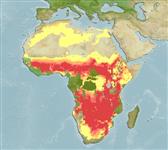分类 / Names
俗名 | 同种异名 | Catalog of Fishes (gen., sp.) | ITIS | CoL | WoRMS | Cloffa
Actinopterygii
辐鳍鱼纲 (条鳍鱼) >
Siluriformes (Catfish) >
Clariidae (Airbreathing catfishes)
Etymology: Clarias: Greek, chlaros = lively, in reference to the ability of the fish to live for a long time out of water; gariepinus: Named after its type locality, the Gariep river, the Hottentot name for the Orange river, South Africa.
环境 / 气候 / 范围
生态学
; 淡水 底中水层性; pH range: 6.5 - 8.0; dH range: 5 - 28; 河川洄游 (Ref. 51243); 深度上下限 0 - 80 m (Ref. 34291). 8°C - 35°C (Ref. 6465), preferred ?; 42°N - 28°S, 17°W - 51°E
Africa: almost Pan-Africa, absent from Maghreb, the upper and lower Guinea and the Cape province and probably also Nogal province. Asia: Jordan, Israel, Lebanon, Syria and southern Turkey. Widely introduced to other parts of Africa, Europe and Asia. Several countries report adverse ecological impact after introduction.
Length at first maturity / 大小 / 重量 / 年龄
Maturity: Lm 30.8, range 34 - ? cm
Max length : 170 cm TL 雄鱼/尚未辨别雌雄; (Ref. 40637); common length : 90.0 cm NG 雄鱼/尚未辨别雌雄; (Ref. 34290); 最大体重: 60.0 kg (Ref. 4537); 最大年龄: 15 年 (Ref. 94815)
背棘 (总数): 0; 背的软条 (总数): 61-80; 臀棘 0; 臀鳍软条: 45 - 65; 脊椎骨: 56 - 63. Diagnosis: body depth 6-8 times in standard length, head 3-3,5 times (Ref. 34290). Head somewhat between rectangular and pointed in dorsal outline; snout broadly rounded; eyes supero-lateral and relatively small (Ref. 248). Teeth on premaxilla and lower jaw small, fine and arranged in several rows; nasal barbels 1/5-1/2 times as long as head in fishes longer than 12 cm, and 1/2-4/5 of head length in smaller individuals; maxillary barbels rarely shorter than head, usually somewhat longer and reaching to a point midway between origin of dorsal fin and insertion of pelvic fins; outer mandibular barbel longer than inner pair (Ref. 34290). Contrary to other Clarias species, Clarias gariepinus has a high number of gill rakers varying from 24-110 (Ref. 248, 34290, 101841), the number increasing with size of the fish; gill rakers long, slender and closely set (Ref. 248, 34290). Distance between occipital process and base of dorsal fin is short; dorsal fin almost reaches caudal fin; anal fin origin closer to caudal fin base than to snout, nearly reaching caudal fin; pelvic fin closer to snout than to caudal fin base; pectoral fin extends from operculum to below 1st dorsal fin rays; pectoral spine robust, serrated only on its outer face, the number of serrations increasing with age; lateral line appears as a small, white line from posterior end of head to middle of caudal fin base; openings to secondary sensory canals clearly marked (Ref. 248).
Colouration: 2 colour patterns can be discerned: uniform and marbled pattern; in uniform pattern, dorsal surface and flanks of body and dorsal parts of pectoral and pelvic fins are generally dark greyish-greenish black, while belly and ventral parts of paired fins are lightly coloured; in marbled pattern, specimens show irregular dark blotches on light coloured background above and laterally, belly and ventral parts of the paired fins are whitish (Ref. 248). Most specimens show pigmentation bands on both sides of lower surface of head (Ref. 248, 81644), but these might be absent (Ref. 101841). A series of light and dark bands may occur on caudal fin; proximal third of caudal fin lightly coloured while other part is dark; occasionally, irregular black spots may occur on caudal fin (Ref. 248). Never an irregular pattern of small white spots on body (Ref. 101841).
Adults occur mainly in quiet waters, lakes and pools (Ref. 248) and prefer rather shallow and swampy areas with a soft muddy substrate and calmer water (Ref. 78218). They may also occur in fast flowing rivers and in rapids (Ref. 248, 78218). Widely tolerant of extreme environmental conditions (Ref. 6465). Water parameters appear to play only a very minor role (Ref. 78218). The presence of an accessory breathing organ enables this species to breath air when very active or under very dry conditions. They remain in the muddy substrates of ponds and occasionally gulp air through the mouth (Ref. 6465). Can leave the water at night using its strong pectoral fins and spines in search of land-based food or can move into the breeding areas through very shallow pathways (Ref. 6868). Are omnivorous bottom feeders which occasionally feed at the surface (Ref. 248). Feed at night on a wide variety of prey (Ref. 6868) like insects, plankton, invertebrates and fish but also take in young birds, rotting flesh and plants (Ref. 6465). Migrate to rivers and temporary streams to spawn (Ref. 34291). Also caught with dragnets. During intra-specific aggressive interactions, this species was noted to generate electric organ discharges that were monophasic, head-positive and lasting from 5-260 ms (Ref. 10479). Known as sharptooth catfish in aquaculture, a highly recommended food fish in Africa (Ref. 52863). Marketed fresh and frozen; eaten broiled, fried and baked (Ref. 9987).
Life cycle and mating behavior
成熟度 | 繁殖 | 产卵场 | 卵 | 孕卵数 | 仔鱼
Oviparous. Spawning takes place during the rainy season in flooded deltas. The fishes make a lateral migration towards the inundated plains to breed and return to the river or lake soon afterwards while the juveniles remain in the inundated area. Juveniles return to the lake or river when they are between 1.5 and 2.5 cm long (Ref. 34291). First sexual maturity occurs when females are between 40-45 cm and males between 35-40 cm. Eggs are greenish. Incubations lasts little (about 33 hours at 25°C).
Teugels, G.G., 1986. A systematic revision of the African species of the genus Clarias (Pisces; Clariidae). Ann. Mus. R. Afr. Centr., Sci. Zool., 247:199 p. (Ref. 248)
CITES (Ref. 94142)
Not Evaluated
人类利用
渔业: 低经济; 养殖: 商业性; 游钓鱼种: 是的
工具
特别资料
下载 XML
网络资源
